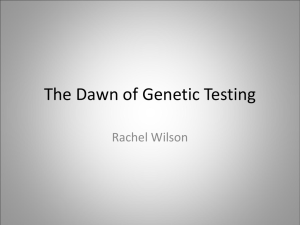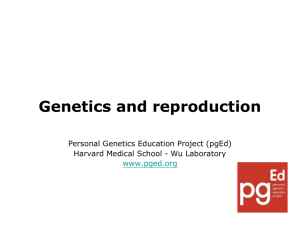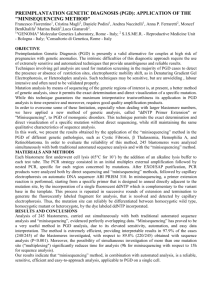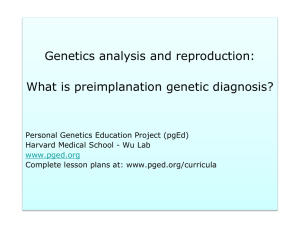Virtual Mentor - AMA Journal of Ethics
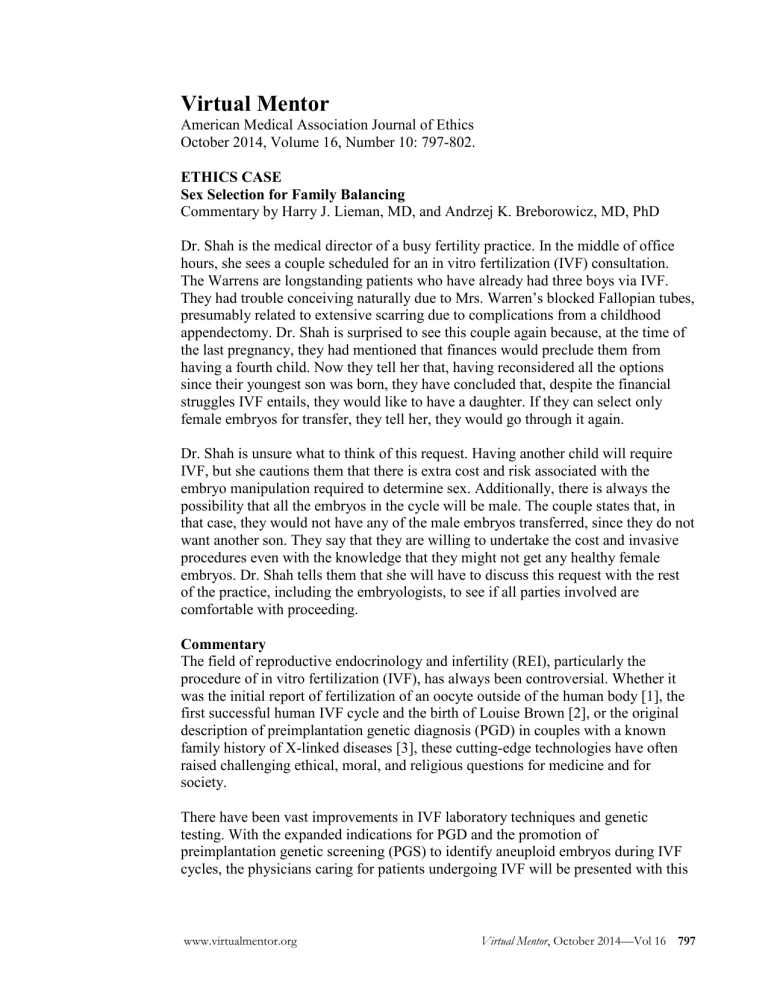
Virtual Mentor
American Medical Association Journal of Ethics
October 2014, Volume 16, Number 10: 797-802.
ETHICS CASE
Sex Selection for Family Balancing
Commentary by Harry J. Lieman, MD, and Andrzej K. Breborowicz, MD, PhD
Dr. Shah is the medical director of a busy fertility practice. In the middle of office hours, she sees a couple scheduled for an in vitro fertilization (IVF) consultation.
The Warrens are longstanding patients who have already had three boys via IVF.
They had trouble conceiving naturally due to Mrs. Warren’s blocked Fallopian tubes, presumably related to extensive scarring due to complications from a childhood appendectomy. Dr. Shah is surprised to see this couple again because, at the time of the last pregnancy, they had mentioned that finances would preclude them from having a fourth child. Now they tell her that, having reconsidered all the options since their youngest son was born, they have concluded that, despite the financial struggles IVF entails, they would like to have a daughter. If they can select only female embryos for transfer, they tell her, they would go through it again.
Dr. Shah is unsure what to think of this request. Having another child will require
IVF, but she cautions them that there is extra cost and risk associated with the embryo manipulation required to determine sex. Additionally, there is always the possibility that all the embryos in the cycle will be male. The couple states that, in that case, they would not have any of the male embryos transferred, since they do not want another son. They say that they are willing to undertake the cost and invasive procedures even with the knowledge that they might not get any healthy female embryos. Dr. Shah tells them that she will have to discuss this request with the rest of the practice, including the embryologists, to see if all parties involved are comfortable with proceeding.
Commentary
The field of reproductive endocrinology and infertility (REI), particularly the procedure of in vitro fertilization (IVF), has always been controversial. Whether it was the initial report of fertilization of an oocyte outside of the human body [1], the first successful human IVF cycle and the birth of Louise Brown [2], or the original description of preimplantation genetic diagnosis (PGD) in couples with a known family history of X-linked diseases [3], these cutting-edge technologies have often raised challenging ethical, moral, and religious questions for medicine and for society.
There have been vast improvements in IVF laboratory techniques and genetic testing. With the expanded indications for PGD and the promotion of preimplantation genetic screening (PGS) to identify aneuploid embryos during IVF cycles, the physicians caring for patients undergoing IVF will be presented with this
www.virtualmentor.org Virtual Mentor , October 2014—Vol 16 797
ethical dilemma of sex selection on a more frequent and regular basis. This should not be surprising to the medical world or society. Once these techniques have gained accuracy and the IVF process has gained acceptance as a way to conceive, the question asked by many will be, “Why not take advantage of the available technology?” Do physicians or professional societies have the right to limit the use of these available techniques? For elective use, as in the scenario highlighted above, many would say yes, they do. Some European countries prohibit the use of PGD for elective sex selection [4, 5]; the US does not regulate PGD nor limit its use to specific indications.
The subject of sex selection generates mixed views, given its medical, ethical, and, potentially, societal implications. These issues revolve around patient autonomy and reproductive liberty, the unknown risks of the procedures to the offspring, the possible fomenting of societal gender bias, and potential limitations on access to medical care. The slippery slope concern is also raised as an argument against elective sex selection: once the threshold of applying the technology for one nonessential indication is crossed, there is reason to believe we will not stop at sex and will seek to select other non-health-related traits in embryos.
Techniques
Currently, there are three available methods for sex selection. The first option is prefertilization sperm sorting using flow cytometry, which can provide a semen sample enriched with sperm that bear the desired sex chromosome. Its accuracy is in the 84-92 percent range, and it is not yet available in the US [6, 7]. At the opposite end of the spectrum, the most extreme form of sex selection occurs after conception in the form of elective termination of pregnancy if prenatal testing shows the sex of the fetus is the opposite of that desired. In certain regions of the world, such as India, such procedures are commonly performed, despite being illegal [8, 9].
A midpoint option is the one presented in the case above, and for some it is the ethically preferable choice because it avoids prenatal determination and possible elective termination [10]. This is preimplantation genetic diagnosis and screening
(PGD/S) of embryos. According to Baruch et al, using data given voluntarily by centers providing PGD to their patients in 2005, approximately 9 percent of reported
IVF/PGD cycles performed in the US in 2005 were done for nonmedical sex selection [11]. In PGD/PGS, the embryos created through IVF undergo biopsy at the cleavage cell stage (on day 3 of existence) or a trophectoderm biopsy of the blastocyst (day 5 of existence). The blastomere cell (or cells) or the trophectoderm cells are sent for genetic testing and only the embryos of the desired sex are transferred. The remaining embryos of the other sex can be discarded or cryopreserved for future use.
Risks
If the Warrens want to have another child at all, Mrs. Warren will be going through
IVF. If they pursued sex selection, they would only need to add the biopsy of the embryos, genetic testing, and selection. These procedures generate additional costs
798 Virtual Mentor , October 2014—Vol 16 www.virtualmentor.org
but do not in themselves expose the patient to any additional risks. There is some evidence that the manipulation of the embryos can be detrimental to their implantation potential [12], and, overall, there is limited data on the impact of biopsies on the risk to the offspring [13, 14]. The Warrens will obviously need to be fully informed of all known risks and implications.
Reasons and Justifications
The Warrens are interested in having a female child for “family balancing.” If this couple had been asking for sex selection with their first attempt at IVF, it would have raised concerns about gender bias and possible societal sex-ratio imbalances. In that setting perhaps the physician caring for the couple would be less inclined to perform the PGD. When couples who are undergoing IVF for medical reasons already have a child or children of one sex and then pursue PGD to identify embryos for transfer of the other sex it raises less concern about contributing to an imbalance of the sexes in the general population.
The more difficult scenarios are sex selection requests from otherwise healthy or subfertile couples without medical indications for IVF. The treatment is driven only by a desire to have a child of a certain sex. Even with IVF risks relatively low for women undergoing the process, the use of a limited health care resource without normal clinical justifications may be cause for concern. Because these elective and nonindicated procedures will not be covered by any insurance, only patients of a certain socioeconomic class would be able to afford them, which might not be equitable. As of this writing, our ethics committee has not permitted patients to undergo IVF for sex selection when IVF is not otherwise indicated.
Ethical Guidance
The American Society for Reproductive Medicine (ASRM) Ethics Committee condones the use of PGD for serious adult-onset conditions for which there are no treatments [15]. Similarly, its most recent committee opinion on “sex selection and preimplantation genetic diagnosis” suggests that it is ethically acceptable to use PGD and sex selection for medical reasons. However, the committee has not come to a consensus on elective sex selection [16, 17]. The use of PGD for elective sex selection, even by couples already undergoing medically indicated IVF, is not encouraged, and certainly initiating IVF and PGD solely for sex selection in fertile patients is discouraged.
The European Society of Human Reproduction and Embryology (ESHRE) Task
Force on Ethics and Law suggests that a cautious approach would be to allow preconception sex selection for family balancing in a setting designed to gain further data about all relevant aspects. The family-balancing requirement could be set at having at least one or at least more than one child of the nonrequested sex in the household. Under the same family-balancing condition, professionals should then also be allowed to fulfil requests
www.virtualmentor.org Virtual Mentor , October 2014—Vol 16 799
for additional sex selection after PGD or PGS, in cases where there are embryos of both sexes and in which the choice between those embryos is not fully determined by medical criteria [18].
Often REI practices that are affiliated with academic institutions have the opportunity to present ethically challenging cases to an ethics committee. As elective sex selection has yet to be considered an accepted practice by the ASRM, it has become standard at Albert Einstein College of Medicine’s Montefiore Medical
Center that all couples requesting sex selection for social, nonmedical reasons have their cases presented to the committee at the medical school. Each case is considered on its own merit. The committee weighs the justifications for the procedure against the potential risk to the couple and the future offspring and the potential impact on society. For treatment to ensue, the committee must arrive at a consensus based on the available facts. The patients making these requests are made aware of this and their treatments are delayed until the committee reviews their cases.
Conclusion
More data on PGD use will help clarify what oversight is needed. Currently, though the ESHRE PGD consortium has already reported on ten years of data [19] and continues to collect, there is only limited data from the US [11]. Within the last two years, the Society for Assisted Reproductive Technologies (SART) has been collecting data prospectively for all PGD cases conducted at SART-affiliated programs in the US. This will permit an adequate assessment of the prevalence and the indications for PGD/S for sex selection. This data will allow professional societies to understand whether current PGD/S use is ethically sound and socially appropriate; if so, they will be able to reassure concerned members of the public, and, if not, they will be able to formulate guidelines and limitations to ensure responsible use.
References
1.
Rock J, Menkin MF. In vitro fertilization and cleavage of human ovarian eggs. Science. 1944;100(2588):105-107.
2.
Steptoe PC, Edwards RG. Birth after the reimplantation of a human embryo.
Lancet. 1978;2(8085):366.
3.
Handyside AH, Kontogianni EH, Hardy K, Winston RM. Pregnancies from biopsied human preimplantation embryos sexed by Y-specific DNA amplification. Nature. 1990;344(6268):768-770.
4.
Soini S. Preimplantation genetic diagnosis (PGD) in Europe: diversity of legislation a challenge to the community and its citizens. Med Law.
2007;26(2):309-323.
5.
Aghajanova L, Valdes CT. Sex selection for nonhealth-related reasons.
Virtual Mentor. 2012;14(2):105-111.
6.
Vidal F, Fugger EF, Blanco J, et al. Efficiency of MicroSort flow cytometry for producing sperm populations enriched in X- or Y-chromosome haplotypes: a blind trial assessed by double and triple colour fluorescent insitu hybridization. Hum Reprod. 1998;13(2):308-312.
800 Virtual Mentor , October 2014—Vol 16 www.virtualmentor.org
7.
Karabinus DS. Flow cytometric sorting of human sperm: MicroSort clinical trial update. Theriogenology. 2009;71(1):74-79.
8.
Macklin R. The ethics of sex selection and family balancing. Semin Reprod
Med. 2010;28(4):315-321.
9.
Jain A. Sex selection and abortion in India. BMJ. 2013;346:f1957.
10.
Steinbock B. Sex selection: not obviously wrong. Hastings Cent Rep.
2002;32(1):23-28.
11.
Baruch S, Kaufman D, Hudson KL. Genetic testing of embryos: practices and perspectives of US in vitro fertilization clinics. Fertil Steril.
2008;89(5):1053-1058.
12.
Scott RT, Jr., Upham KM, Forman EJ, Zhao T, Treff NR. Cleavage-stage biopsy significantly impairs human embryonic implantation potential while blastocyst biopsy does not: a randomized and paired clinical trial. Fertil
Steril. 2013;100(3):624-630.
13.
Desmyttere S, De Rycke M, Staessen C, et al. Neonatal follow-up of 995 consecutively born children after embryo biopsy for PGD. Hum Reprod.
2012;27(1):288-293.
14.
Nekkebroeck J, Van den Broeck W, Desmyttere S, Ponjaert-Kristoffersen I,
Bonduelle M. The mental, motor, socio-emotional and language development of 2-year-old twins born after PGD/PGS and parental well-being. Hum
Reprod. 2012;27(1):299-301.
15.
Ethics Committee of the American Society for Reproductive Medicine. Use of preimplantation genetic diagnosis for serious adult onset conditions: a committee opinion. Fertil Steril. 2013;100(1):54-57.
16.
Ethics Committee of the American Society of Reproductive Medicine. Sex selection and preimplantation genetic diagnosis. Fertil Steril.
1999;72(4):595-598.
17.
Ethics Committee of the American Society of Reproductive Medicine. Sex selection and preimplantation genetic diagnosis. Fertil Steril. 2004;82 (Suppl
1):S245-248.
18.
Dondorp W, De Wert G, Pennings G, et al. ESHRE Task Force on ethics and law 20: sex selection for non-medical reasons. Hum Reprod.
2013;28(6):1448-1454.
19.
Harper JC, Wilton L, Traeger-Synodinos J, et al. The ESHRE PGD
Consortium: 10 years of data collection. Hum Reprod Update.
2012;18(3):234-247.
Harry J. Lieman, MD, is an associate professor of clinical obstetrics and gynecology and women’s health and the director of the Division of Reproductive Endocrinology and Infertility at Albert Einstein College of Medicine and Montefiore Medical Center in New York City.
Andrzej K. Breborowicz, MD, PhD, is a reproductive endocrinology and infertility fellow in the Department of Obstetrics and Gynecology and Women’s Health at
Albert Einstein College of Medicine and Montefiore Medical Center in New York
City.
www.virtualmentor.org Virtual Mentor , October 2014—Vol 16 801
Related in VM
Sex Selection for Nonhealth-Related Reasons , February 2012
Sex Selection for Nonmedical Reasons , June 2007
Selecting the Traits of Children Prior to Birth , February 2012
Shared Decision Making about IVF for Savior Siblings , January 2014
AMA Code of Medical Ethics ’ Opinions on Assisted Reproductive Technology ,
October 2014
The people and events in this case are fictional. Resemblance to real events or to names of people, living or dead, is entirely coincidental.
The viewpoints expressed on this site are those of the authors and do not necessarily reflect the views and policies of the AMA.
Copyright 2014 American Medical Association. All rights reserved.
802 Virtual Mentor , October 2014—Vol 16 www.virtualmentor.org


